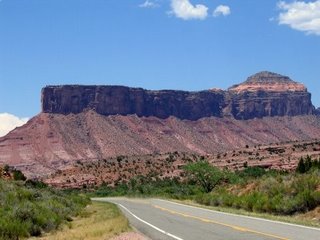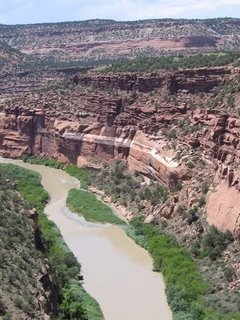Mesa to Telluride via Unaweep/Tabeguache Scenic and Historic Byway 180 miles
On Sunday, we drove 180 miles from Mesa to Telluride via Hwys 141 & 145, the Unaweep/Tabeguache Scenic and Historic Byway. This is not the fastest way to get to Telluride, but it proved to be an incredibly beautiful drive, beginning with 43-mile long Unaweep Canyon, which runs northeast-southwest and cuts through the Uncompahgre Plateau, and going on south, through the Dolores and San Miguel River valleys. Unaweep is a Ute Indian word meaning Canyon with Two Mouths. The Utes named it that because Unaweep is the only canyon in the world that has a divide in the middle (Unaweep Divide), with streams running out of both ends: East Creek, which drains east, to the Gunnison River, and West Creek, which drains west, to the Dolores River.
 From our starting point at Mesa we drove to Grand Junction, then took Hwy 50 to Whitewater, where we turned southwest, onto Hwy 141, the beginning of Unaweep Canyon. In the canyon, both sides of the road were flanked with spectacular, towering (up to 3000 feet above the road) grey (Dakota) and dark red (Wingate) sandstone and granite cliffs.
From our starting point at Mesa we drove to Grand Junction, then took Hwy 50 to Whitewater, where we turned southwest, onto Hwy 141, the beginning of Unaweep Canyon. In the canyon, both sides of the road were flanked with spectacular, towering (up to 3000 feet above the road) grey (Dakota) and dark red (Wingate) sandstone and granite cliffs.Approximately 22 miles into the canyon, we saw the ruins of the Driggs Mansion, in front of a geographic landmark, Thimble Rock. Despite its name, Driggs Mansion wasn’t a mansion at all, but a simple, 6-room, hunting lodge/house, that was built for a wealthy New York lawyer, author and editor, Laurence La Tourette Driggs, between 1914 and 1918. Mr. Driggs hired a local Italian stone mason, Nunzio Grasso, to construct the 6-room hunting lodge/house on 320 acres of land, using water from West Creek. Sandstone cut from nearby Mayflower Canyon was used for the walls of the place. According to local legend, the Driggses moved in after construction was completed in 1918, only to leave after just a few weeks. Colonel Driggs subsequently sold the property in 1923, after which the building was used as part of a ranching operation until the 1940's. The roof was removed in the 1940's, and many of the stones from the walls were carried away in the 1950's, leaving the ruins that are visible today. In September, 2005, Driggs Mansion was added to The Colorado State Register of Historic Properties.


Driggs Mansion, shortly after it was built, and Driggs ruins, current
A few miles beyond the Driggs Mansion is the Unaweep Seep, aka "Swamp Hill”. This is a 55-acre area where natural springs, seeping through the rock, have created a marshy, riparian ecosystem (basically, a wet meadow) that is one of the few known habitats of a rare butterfly, Nokomis Fritillary. We didn’t stop there (and didn’t see any butterflies) but continued driving west along Hwy 141, through the remainder of Unaweep Canyon, to the town of Gateway. We stopped at Gateway so I could photograph this old Mobil Oil Pegasus at the gas station/motel/cafe/grocery store:

At Gateway, Hwy 141 meets the Dolores River (a tributary of the Colorado River) and turns south, following the river through the Dolores River Canyon. Approximately 40 miles down the road (marker 83.5), I spotted a dome-shaped coke oven on the west side of the road. Built in the 1880's, the oven was used to heat coal to produce coke, an almost smoke-free fuel. Coke from this oven may have been used by blacksmiths during the construction of the Hanging Flume.

Coke oven (not my pic)
Dolores River Canyon with Hanging Flume ruins, highlighted
 Flume ruins, highlighted
Flume ruins, highlighted


A couple of miles beyond the coke oven, we came to Hanging Flume Turnout. Merriam-Webster defines flume as an inclined channel for conveying water, and that is exactly what I was looking at, or at least, the remnants of that, still amazingly suspended over a hundred feet above the canyon floor, on the face of the dark red, Wingate Sandstone cliffs of the Dolores River Canyon. In the late 1880's, gold was being mined in the San Juan Mountains of Dolores Canyon by the Montrose Placer Mining Company, but hydraulic power was required to separate the gold ore from the rock. Although the Lone Tree Placer site was just 40 feet above the Dolores River, the technology to pump the water directly from the river to the site at the volume and pressure necessary to separate the gold ore from the rock had not yet been developed. Accordingly, the Montrose Placer Mining Company decided to construct the Hanging Flume, to provide the hydraulic power required to operate the mining equipment. Construction of the 4' deep, 5' wide, 13-mile long Flume was begun in 1888, and completed in 1891. During the brief period of its operation, the flume delivered over 23 million gallons of water each day from the San Miguel River to the Lone Tree Placer site. However, there wasn’t enough gold in the mine to cover the costs of the investment. The Montrose Placer Mining Company declared bankruptcy shortly after completion of the flume, which was then abandoned. The Flume is listed on the National Register of Historic Places.
We continued driving on 141, past the ghost town of Uravan, once a thriving mining town. Uravan was named by taking the first three letters of the uranium and vanadium (used in hardening steel) that were mined there from the 1930's through 1984 by the U.S. Vanadium Corporation, a subsidiary of Union Carbon & Carbide Corporation. Some of the uranium used to produce the first atomic bombs came from Uravan. A little beyond Uravan is another town with an unusual name: Nucla. Nucla was the home of the west’s first agricultural commune. According to Wikipedia, “Its name comes from the town's founders intent that it serve as a "nucleus" for the surrounding farms and mines, although it has since come to be associated with the growth of uranium mining in the region.”
In late afternoon, we drove into Telluride, which is located in a stunning box canyon.


We had a sandwich and a beer at the Brown Dog Café, and then walked around town a bit before going to A's friend's beautiful Victorian house, where we spent the night.

7 comments:
Dang, Woman, you sure do get around! You make my trip to Vermont look like hopscotch.
Great trip, Judy. That hanging flume is amazing. Your series of entries make grea reading.
Wow you've been busy lol Sounds like so much fun. Pretty pictures too.
~Lily
How wonderful to be able to stay with friends along the way. Looking forward impatiently to the rest of the story.
*debbi*
Telluride's box canyon was stunning!
HUGS
Very dramatic scenery. I love the west.
Wonderful!
V
Post a Comment